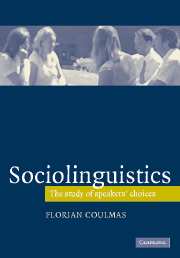Book contents
- Frontmatter
- Contents
- 1 Introduction: notions of language
- Part I Micro-choices
- Part II Macro-choices
- 7 Code-switching: linguistic choices across language boundaries
- 8 Diglossia and bilingualism: functional restrictions on language choice
- 9 Language spread, shift and maintenance: how groups choose their language
- 10 Language and identity: individual, social, national
- 11 Language planning: communication demands, public choice, utility
- 12 Select letters: a major divide
- 13 The language of choice
- Glossary of terms
- References
- Internet resources
- Index
- References
8 - Diglossia and bilingualism: functional restrictions on language choice
Published online by Cambridge University Press: 05 June 2012
- Frontmatter
- Contents
- 1 Introduction: notions of language
- Part I Micro-choices
- Part II Macro-choices
- 7 Code-switching: linguistic choices across language boundaries
- 8 Diglossia and bilingualism: functional restrictions on language choice
- 9 Language spread, shift and maintenance: how groups choose their language
- 10 Language and identity: individual, social, national
- 11 Language planning: communication demands, public choice, utility
- 12 Select letters: a major divide
- 13 The language of choice
- Glossary of terms
- References
- Internet resources
- Index
- References
Summary
– About my school, mum, dit l'enfant en marchant vers l'arrêt d'autobus.
– Oui? Dit la maman.
– It's a great school, isn't it?
– Oui, c'est une école formidable, répond-elle avec sincérité.
– The best school in town?
– La meilleure de la ville, oui.
Pierrette Flatiaux, Allons-nous être heureux?Linguistic or cultural homogeneity of even one group is in a sense a fiction.
D. P. Pattanayak (1985: 402)In communication speakers take into account normative expectations acquired in the course of socialization which allow them to anticipate the consequences of their linguistic choices. So far, we have discussed a number of social variables that affect choices, including the choice of codes which may be different languages or dialects of the same language. The range of choices is variable, but that speakers can and have to choose from more than one code is very common, both in bilingual societies and in monolingual ones whose members think of themselves as making choices between two noticeably diverse varieties of one language. In a number of cases, choice of these varieties does not depend on region, class, gender or age, but primarily on function and context. Such a configuration is known as ‘diglossia’. In this chapter we will first examine the specifics of a diglossic situation and then compare it with other forms of societal bilingualism.
- Type
- Chapter
- Information
- SociolinguisticsThe Study of Speakers' Choices, pp. 126 - 145Publisher: Cambridge University PressPrint publication year: 2005
References
- 1
- Cited by

